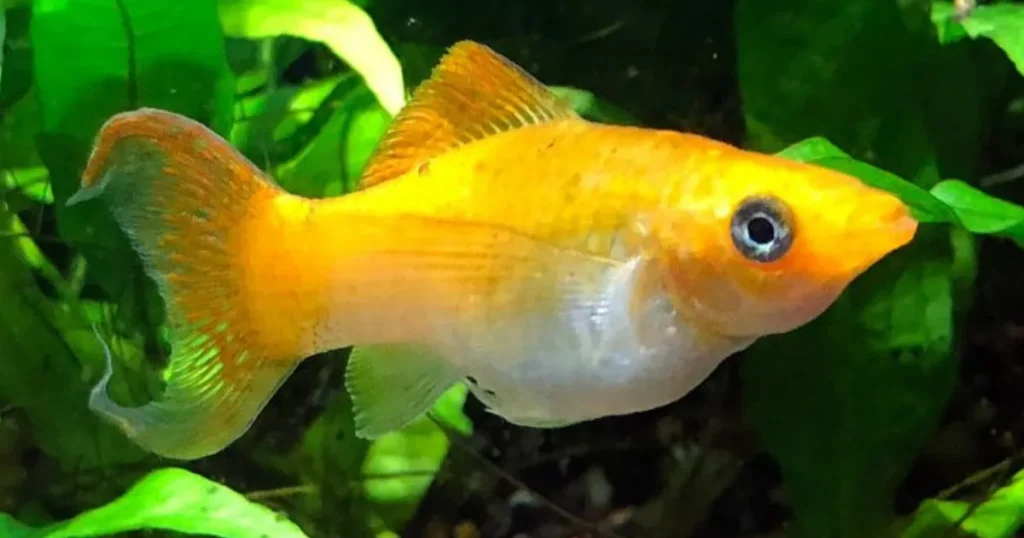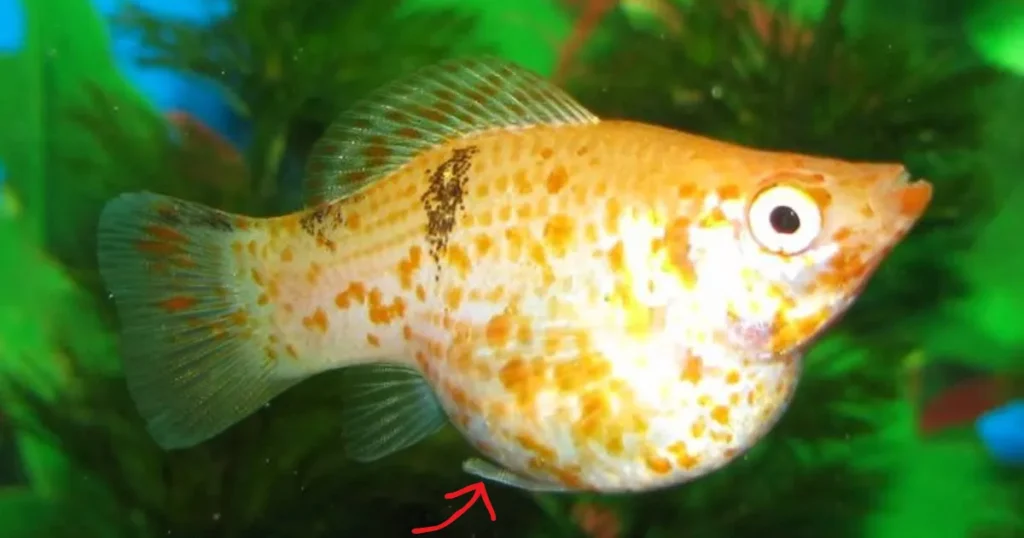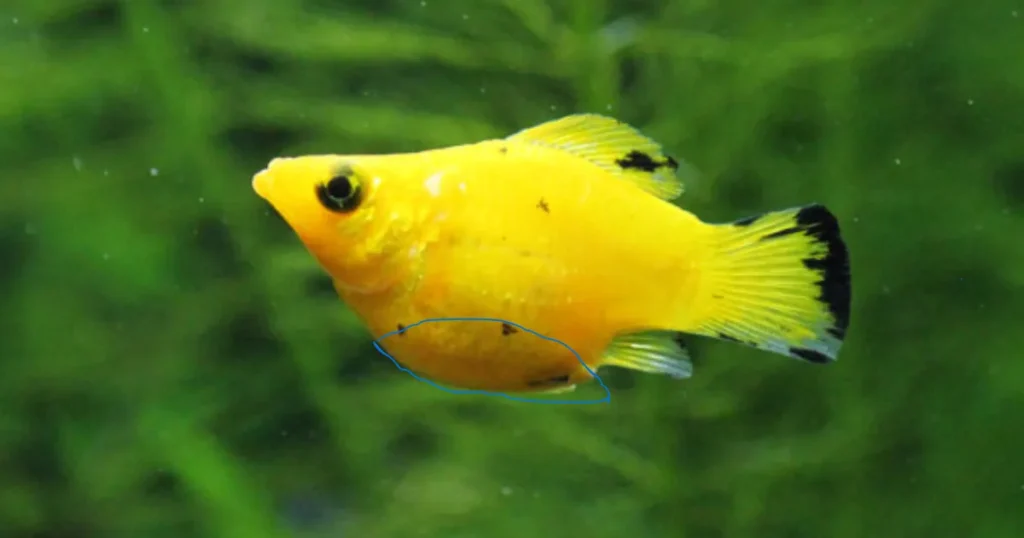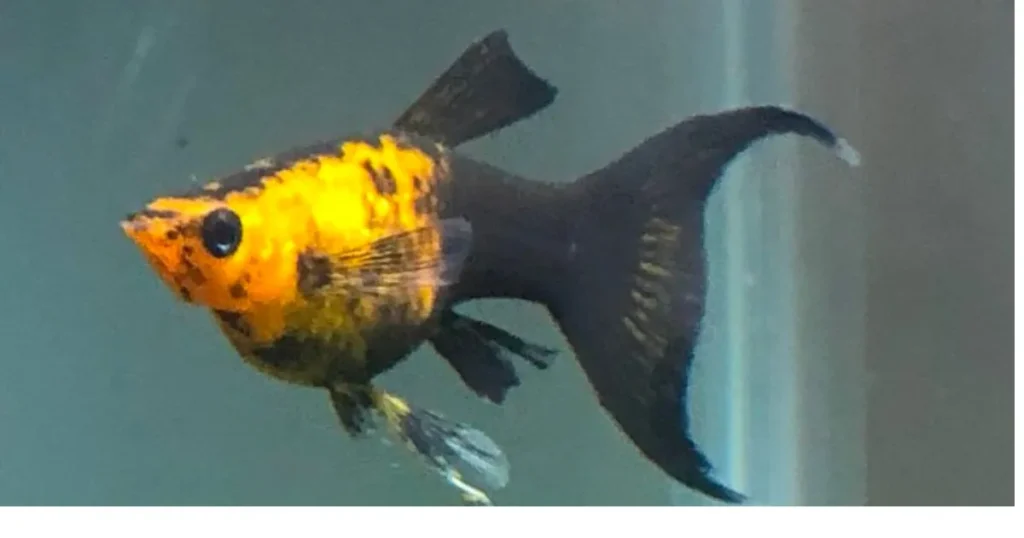The appearance of a plump, square-shaped molly swimming in your aquarium often raises questions – could she be pregnant? Identifying a pregnant molly fish early allows you to provide ideal care for both mom-to-be and developing fry.
In this article, we’ll guide you through telling signs that betray a pregnant molly fish. You’ll learn how to recognize physical symptoms, behavioral cues, and the fascinating developmental changes in expectant mollies. Let’s dive in!
How Can You Tell If a Molly Fish Is Pregnant?
A “pregnant molly fish” is technically a gravid female carrying a brood of developing embryos inside her. Identifying this gravid state early is crucial for providing attentive care. Fortunately, a number of clear signs betray an expecting mother molly-to-be.

An observant aquarist can recognize several physical and behavioral tells that signal pregnancy in female mollies:
Physical Signs
Swollen Belly
- As eggs/embryos grow, the female’s belly expands outwards and downward
- The abdomen becomes rounded, almost box-shaped in the final days before birth
Gravid Spot
- A dark gravid spot becomes visible near the anal vent
- This black or gray marking indicates developing eggs/fry inside
Increased Size
- Pregnant mollies exhibit accelerated growth as nutrition is diverted to the brood
- A pregnant female may surpass the male/other females in overall size
Behavioral Cues
Increased Appetite
- Higher food intake is needed to support the development fry
- Pregnant mollies graze more actively and become bold at feeding times
Aggression
- Pregnant females defend their space more vigorously, chasing away tankmates
- Their maternal protection instincts intensify as the birth date nears
Reclusiveness
- A gravid molly seeks isolation from others, staying among plants/decor
- She retreats to shelter for privacy and security as her body slows with the brood’s weight
What Does a Pregnant Molly Fish Look Like?
The most distinctive visual symptom of a pregnant molly fish is dramatic abdominal changes:
- The belly swells out prominently on both sides, giving a widened, rectangular body profile when viewed head-on. This “boxy” torso shape is a dead giveaway.
- As birth nears, the swollen abdomen may appear lopsided, with one side bulging out further as fry crowd to one side.
- The dark gravid spot intensifies in color near the anal vent, signaling developing embryos.
- Nesting females also display a noticeably enlarged and reddened papilla – their female genital opening that releases newborn fry.
Multiple clear physical transformations indicate a female molly is expecting, if you know what to look for!
Let’s explore the most common physical and behavioral indicators that reveal a female molly is expecting:
Square Shape and Inflated Belly

- The female’s belly will take on a distinctly box-like shape as it widens and fills with developing embryos.
- When viewed top-down, the abdomen appears rectangular compared to a non-pregnant molly’s more rounded profile.
- The belly continues to swell outwards and downwards dramatically in the final days before giving birth.
- This abdominal expansion is one of the clearest visual symptoms of pregnancy versus just weight gain.
Dark Gravid Spot
- A prominent dark gray, black, or brown marking emerges near the anal opening region.
- This “gravid spot” results from melanin pigment concentrated around developing eggs and embryos.
- The coloration intensifies as the birth date draws nearer and the brood matures.
- Females without a visible gravid spot are likely, not pregnant even if showing other signs like appetite changes.
Increased Appetite and Growth
- Supporting a growing brood demands extra nutrition, so pregnant mollies eat noticeably more.
- They may aggressively dart after food at feeding times and graze constantly on algae/surfaces.
- The extra calories also spur accelerated bodily growth – pregnant females often surpass tankmates in size.
- However, take care not to overfeed, as excess weight could be mistaken for pregnancy.
Aggressive Behavior
- Guarding her developing brood, pregnant mollies turn aggressive toward tankmates.
- They zealously defend their space from intruders, chasing away other fish.
- Nipping fins and targeting fish that approach her shelter are common behaviors.
- This heightened aggression peaks right before birth as maternal protection instincts strengthen.
Nesting Instincts
- As the birth date nears, pregnant females seek isolation from others.
- They retreat to thick plants, caves, and shelters to establish a secluded birthing area.
- Choosing a quiet, discrete space to deliver offspring reduces threats from predators.
- Instinct drives them to give birth away from disturbances and the hustle of tank life.
Labor Signs
- In the final days before birth, clear signs of impending labor emerge:
- Lethargy and loss of appetite as the heavy brood tires the female.
- Faster breathing and intensified straining as the body prepares for delivery.
- A markedly enlarged and reddened papilla – the genital opening from which fry will emerge.
Pregnant Molly Fish Stages
A Pregnant Molly Fish Stages can be divided into three main phases as the brood develops:

Early Stage – Fertilization
- Mating begins with the male molly depositing sperm packets onto the female’s genital opening.
- The female draws these spermatophores inside and stores them in an internal pouch.
- As her eggs mature in the ovaries, these stored sperm will fertilize the eggs through internal self-fertilization.
- In these first days, there are no external signs yet as fertilized eggs embed and divide within the ovarian follicles.
Mid-Term – Gestation
- Now embryos begin growing within eggs contained inside the female’s ovaries. The eggs swell within their ovarian follicles.
- The abdomen expands as the ovaries enlarge to accommodate the developing brood. A dark gravid spot becomes visible near the anal fin.
- The pregnant female’s appetite increases to provide nutrients to the growing fry. Her territorial aggression also rises.
- By mid-term, a widening belly and darkened gravid spot clearly signal pregnancy to a watchful aquarist.
Late Stage – Fry Fully Formed
- In the final week before birthing, the fry grows rapidly, crowding the abdomen. The swollen belly is now prominent behind the dorsal and pectoral fins.
- Nesting behaviors intensify as females isolate themselves among plants and decor to establish a discreet birthing area away from threats.
- Breathing quickens, appetite declines, and lethargy increases as females prepare for the exertion of labor and delivery.
- The female strains intensely to deliver fully developed, free-swimming fry through the enlarged papilla opening.
What to do if your molly fish pregnant?
If you have a pregnant molly fish, there are several steps you can take to ensure a healthy and stress-free pregnancy:
- Provide a Suitable Environment: Adjust the tank conditions to be ideal for a pregnant molly. Maintain stable water parameters, including temperature and pH.
- Offer Hiding Spots: Create hiding spots using plants or decorations to give the pregnant molly a sense of security. This helps reduce stress.
- Use Breeding Boxes: Consider placing a breeding box in the tank. These floating containers provide a secluded area for the pregnant molly to give birth without interference from other fish.
- Tailor the Diet: Feed a well-balanced and nutritious diet, including high-quality flakes, pellets, and occasional treats. Pregnant mollies may benefit from live or frozen foods to enhance their nutritional intake.
- Monitor Behavior: Keep a close eye on the pregnant molly’s behavior. If she shows signs of distress or aggression from tankmates, consider separating her temporarily.
- Prepare for Birth: As the due date approaches, the molly will display specific behaviors indicating she is ready to give birth. Provide ample hiding spots for fry, as molly fish can eat their own young.
You May Like: Is My Angelfish Pregnant?
Caring for Pregnant Molly fish.
Once a female molly’s pregnancy is apparent, some adjustments help support her and developing fry:

Provide More Hideouts
Give ample plants, caves, and decor for privacy during brooding and birthing away from threats. Floating plants offer a comforting canopy.
Add a Breeding Box/Trap
A mesh trap retains newborn fry while allowing water flow. The female can give birth inside, then be removed after. Fry can exit the trap through slits when ready.
Feed High-Quality Foods
Pregnant molly fish need increased protein and micronutrients. Feed nutrient-rich live, frozen, or freeze-dried foods like daphnia, brine shrimp, and Veggie Rounds.
Maintain Stable Water Parameters
Test for and promptly remove ammonia, nitrites, and nitrates through water changes. Mollies thrive in slightly brackish water too.
Reduce Stressors
Dim aquarium lights, limit noise/vibrations and provide a floating betta log for shelter if harassed by aggressive tankmates.
With some attentive care, you can help your pregnant molly thrive right up to delivery day!
Differentiate Between Fat vs Pregnant Molly Fish.
Here are some tips for differentiating between a fat vs Pregnant molly fish:
- A fat molly will show weight gain throughout the entire body and lack a darkened gravid spot near the anal fin. A pregnant female mainly shows an abdominal bulge and distinct gravid marking.
- Fat mollies simply appear big all over. Pregnant females display a more box-shaped belly that widens behind the dorsal fin.
- Overweight mollies exhibit no behavioral changes. Pregnant mollies show increased aggression, appetite, nesting instincts, and labor signs.
- Fat results from overfeeding and inactivity. Pregnancy causes abdominal changes related to the developing brood.
- With fat fish, the belly will not grow noticeably within days. A pregnant molly’s abdomen can expand rapidly as it fills with eggs/fry.
- Feeding a fatty molly smaller meals, and veggies helps slim it down. Pregnant fish should receive extra protein-rich foods.
- If uncertain, isolate the molly. If the bulge resolves in 1-2 weeks, it’s likely just fat. A persisting swollen belly indicates pregnancy.
How to know if a molly fish is pregnant or has dropsy?
Distinguishing between a pregnant molly and one with dropsy is crucial for proper care. Here are the key differences:
- Pregnant Molly:
- Abdominal Swelling: A pregnant molly will exhibit a gradual and uniform abdominal swelling, usually towards the back of the body.
- Dark Gravid Spot: Look for a dark spot near the anal vent. This gravid spot is a clear indicator of pregnancy.
- Normal Behavior: Pregnant mollies will generally exhibit normal swimming behavior and show interest in food.
- Molly with Dropsy:
- Abdominal Swelling: Dropsy causes a sudden and extreme swelling of the entire abdomen, giving the fish a pinecone-like appearance.
- Raised Scales: One of the most characteristic signs of dropsy is raised scales, creating a pinecone-like texture on the fish’s skin.
- Lethargy and Loss of Appetite: A molly with dropsy will likely display lethargy, a lack of interest in food, and may isolate itself from other fish.
If you suspect dropsy, it is crucial to isolate the affected molly immediately and seek advice from a qualified veterinarian or a knowledgeable aquarium professional. Dropsy is often a symptom of an underlying health issue, and
FAQs.
Let’s wrap up by addressing some frequent questions about gravid mollies:
How Often Do Mollies Give Birth?
Given ideal conditions, mollies can give birth every 6-8 weeks, producing broods of 40-60 fry. Females store sperm to self-fertilize multiple successive broods.
How to Differentiate Between Overweight And Pregnant Molly Fish?
While overfed mollies may look plump, pregnant females display key signs like the darkened gravid spot, aggressive behaviors, isolation instincts, enlarged papilla, and a distinctly boxy abdomen shape.
Can Mollies Have False Pregnancies?
Yes, mollies may demonstrate pregnancy behaviors even if not actually gravid. This is due to hormonal changes. Look for physical signs like the swollen belly and gravid spot to confirm true pregnancy.
Conclusion
We hope this comprehensive guide has helped equip you with the knowledge to identify a pregnant molly fish in your aquarium. Recognizing the distinct physical and behavioral shifts gravid mollies undergo enables you to provide attentive care for both the expecting mother and her developing brood. The dramatic abdominal swelling, darkened gravid spots, increased appetite, and seclusion instincts tell that your female molly is carrying the next generation. Understanding the fascinating journey from fertilization to birth allows you to be ready for the exciting arrival of a new fry.
With a well-informed eye and appropriate adjustments to nutrition, tank conditions, and reducing disturbances, you can support your pregnant molly’s needs at every stage. Your diligent efforts will be rewarded with a smooth pregnancy culminating in the successful delivery of healthy, active fry.
We encourage you to share your own experiences with breeding and caring for pregnant mollies. Please also reach out with any questions – there is always more to learn about these fantastic live-bearing fish! Maintaining a thriving, growing aquarium family
